Top 10 Design Fonts of All Time: Timeless Typefaces
Hello, font lovers! Are you excited to learn about typefaces that have shaped design history?
We will look at the best design fonts that remain relevant over many years and still impact designers globally. These letter sets revolutionised visual communication from minimal sans serifs to decorative serifs.
Without further ado, here are my top 10 favourite design fonts ever created.
- Timeless typefaces like Helvetica and Garamond have shaped design and typography history, remaining influential across various media.
- Key characteristics of these fonts include adaptability, legibility, and aesthetic appeal, making them essential for designers.
- Understanding the legacy of classic fonts informs modern design choices and helps maintain effective communication through typography.
1. Helvetica: The Swiss Army Knife of Fonts
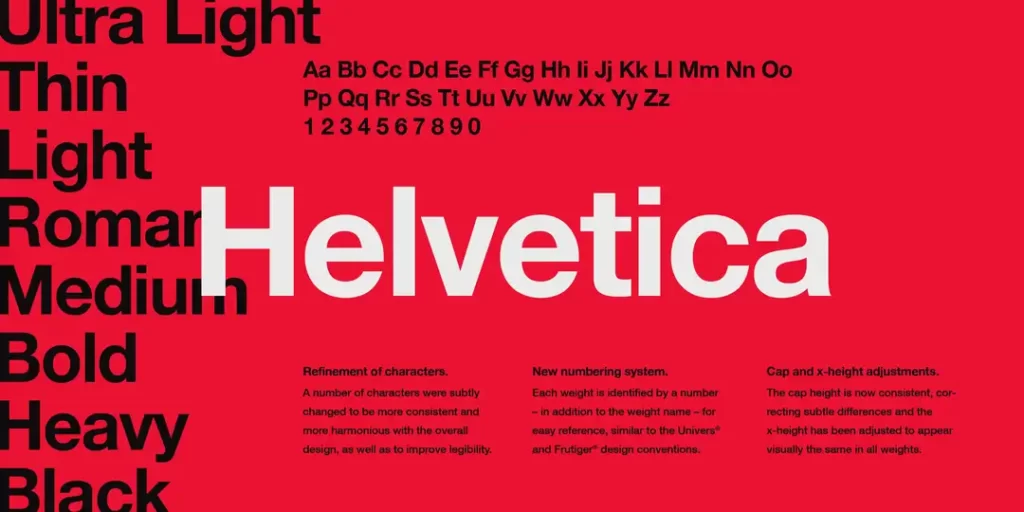
When considering adaptability, no other font can compete with Helvetica. This typeface was created in Switzerland in 1957 and has since remained the most popular choice among designers worldwide. Here is why:
Birth of an Icon
Helvetica did not just appear out of nowhere. At that time, designers needed a clean and neutral typeface that could be applied to various uses; Max Miedinger and Eduard Hoffmann designed one, which changed graphic design forever.
What Defines Helvetica
But what is it about Helvetica? These are some notable characteristics:
- Clean sans-serif shape;
- Higher x-height for better legibility;
- A non-distinctive look that does not call attention to itself;
- Variations in weight – from extremely thin to super bold.
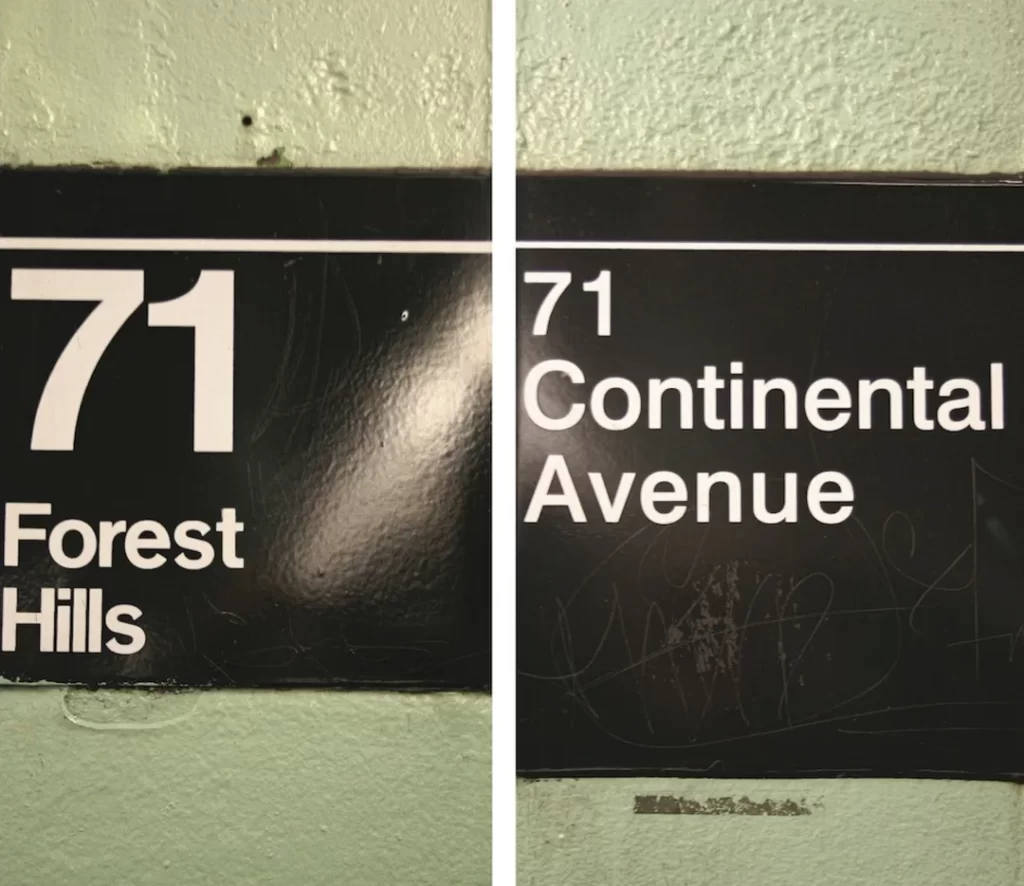
The Ubiquitousness of Helvetica
Perhaps you do not realise it, but this font surrounds us. Corporate logos, street signs – everywhere we look! Such popularity demonstrates its timeless aesthetic appeal combined with practicality.
Helvetica in the Digital World
Despite the growing dominance of digital designs over recent years, Helvetica remains relevant even now thanks to being adaptable for screen use and continuing popularity amongst web and user interface (UI) designers. This shows true staying power.
2. Garamond: The Timeless Serif

If Helvetica is the king of sans-serif typefaces, then Garamond is the undisputed monarch of serifs. This graceful font has existed since the 16th century, so it’s had time to perfect itself. Let’s find out what makes Garamond so unique.
A Font with Pedigree
The story of Garamond begins with Claude Garamond, a Frenchman who created this typeface during the 1500s. Many versions have been made since then, all paying tribute to its elegant origins.
The Hallmarks of Garamond
What are some distinguishing characteristics that separate Garamond from other serif fonts? Here they are:
- Elegant old-style serifs
- Delicate contrast between thick and thin strokes
- Wide apertures for better legibility at small sizes
- Slightly inclined stress in round letters like ‘o’ or ‘e.’

Garamond in print & digital media
This beautiful lettering can be found throughout many printed materials ranging from classic novels to current magazine publications. It has also successfully entered digital formats, proving these fonts’ adaptability across platforms.
The Garamond Revival
Over recent years, there has been renewed interest towards different variations of Garamond by designers who have started appreciating their timeless aesthetic values more while incorporating them into traditional and modernistic designs.
3. Futura: The Font of Tomorrow

In 1920, Paul Renner created Futura with the future in mind. He had no idea that this typeface would go on to become one among hundreds of others used throughout the twentieth and twenty-first centuries as he did his work. But let’s look at what exactly makes it so different:
The Bauhaus Movement
Futura was born from the clean lines and geometric shapes emphasised by the Bauhaus movement. These principles can be seen in its design, making this typeface an excellent representation of modernist ideals.
Unique Qualities Of Futura
What are some things that make Futura distinctive among other sans-serif fonts? Here are a few:
- Shapes based on circles and triangles
- Tall ascenders and descenders
- Even width all around
- A wide range of weights & styles are available
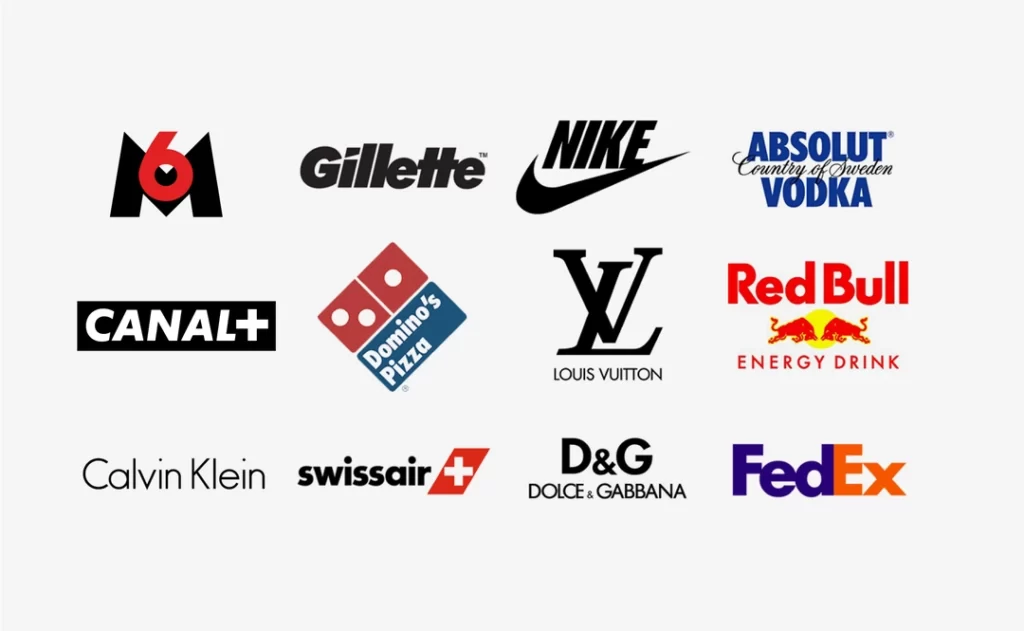
Famous Uses In Pop Culture
Film posters or album covers – you name it! Futura has been everywhere in popular culture, primarily associated with forward-thinking design, attracting brands wishing to appear current or progressive.
Flexibility Of Futura Typeface Family
For being such a strong-willed font, it sure does get along well in any situation! Whether used large for headlines or small within body text – designers should value this tool because they never know when they might need it!
4. Times New Roman: The Newspaper Staple

When considering classic typefaces, the one that usually comes to mind is Times New Roman. This serif font has existed for many years and is still widely used in print media. But its influence doesn’t stop at newspapers. Here’s a look into the history of this iconic typeface.
From The Times to the World
Times New Roman was commissioned by The Times newspaper in 1931, with Victor Lardent designing it under Stanley Morison’s direction. It aimed at making narrow columns more readable in newspapers.
The Anatomy of Times New Roman
What sets Times New Roman apart? Below are some key characteristics:
- Moderate contrast between thick and thin strokes
- Slightly condensed letterforms for space efficiency
- Sturdy serifs that improve small-size legibility
- Balanced proportions give it a classic, timeless feel
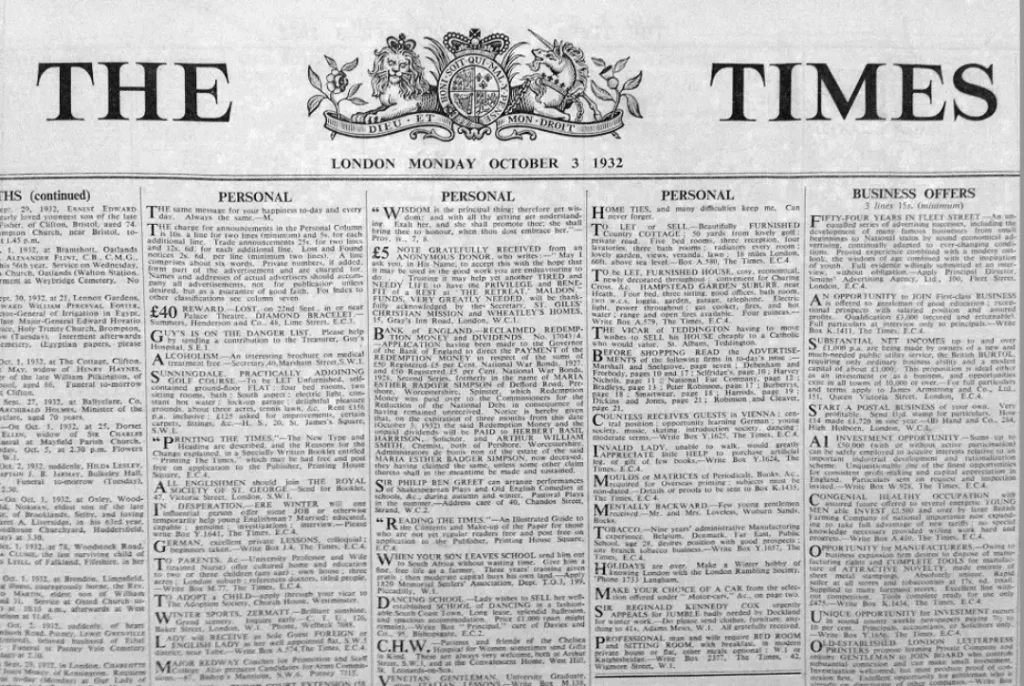
Times New Roman in the Digital Era
As we transitioned from print to screen during digital typography’s rise, so too did this font family. Word processing software in the early days used it as one of their standard fonts, thus cementing itself into our digital lives.
The Legacy of Times New Roman
While some designers feel like they’ve seen enough of TNR – arguing that its ubiquity makes other options less likely to be considered – there can be no denying what an important role this typeface played throughout typographic history, even today serves as a benchmark against which many other serifs may still measure up (or not).
5. Bodoni: The Fashion Font

If fonts had a catwalk, Bodoni would be the supermodel. The elegant serif has always been a staple in the fashion industry and luxury branding. Let’s delve into what makes Bodoni so attractive.
The Birth of Modern Typography
In the late 18th century, Giambattista Bodoni designed this typeface, indicating the ‘modern’ fonts as we know them today. During that time, it was revolutionary because of its bold contrast and geometric structure.
Bodoni’s Striking Features
What sets this font apart from others? Here are some key points about it:
- There is an extreme difference between thick and thin strokes;
- Hairline serifs;
- Vertical stress in round letters;
- Geometrically constructed, yet slightly calligraphic.
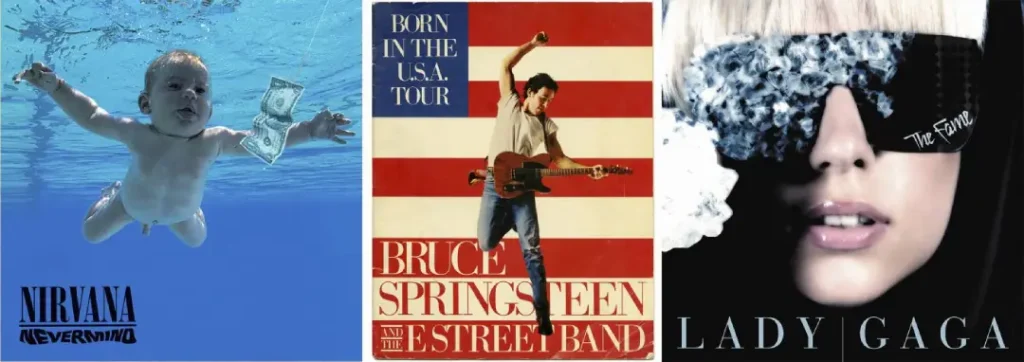
Bodoni in High Fashion
How did Bodoni become synonymous with fashion? Its design is elegant with high contrast, which mirrors the world of haute couture, where dramatic visuals and intricate details reign supreme.
The Many Faces of Bodoni
Different designers have made versions of Bodoni over time, each with slight differences but still being considered as such by many people. This range only serves to make it more appealing and adaptable
6. Baskerville: The Transitional Trendsetter

Baskerville is a type of font that falls between traditional and modern serifs, which means it has always been a part of the history of typography. John Baskerville created this “transitional” typeface in the 1750s, still influencing designers today. What exactly is it that makes Baskerville so long-lasting?
The Connection between Old and New
When Baskerville came about, many changes were happening within typesetting; some things stayed from before, while others were introduced later when people started making fonts that we now consider modern ones.
Distinctive Characteristics
What differentiates this style from any other? Here are a few key features:
- Thick-to-thin stroke contrast (more than old-style serifs)
- More vertical italics
- Pointed corners with clean-cut finishers
- Spaces in darker areas made larger for better legibility
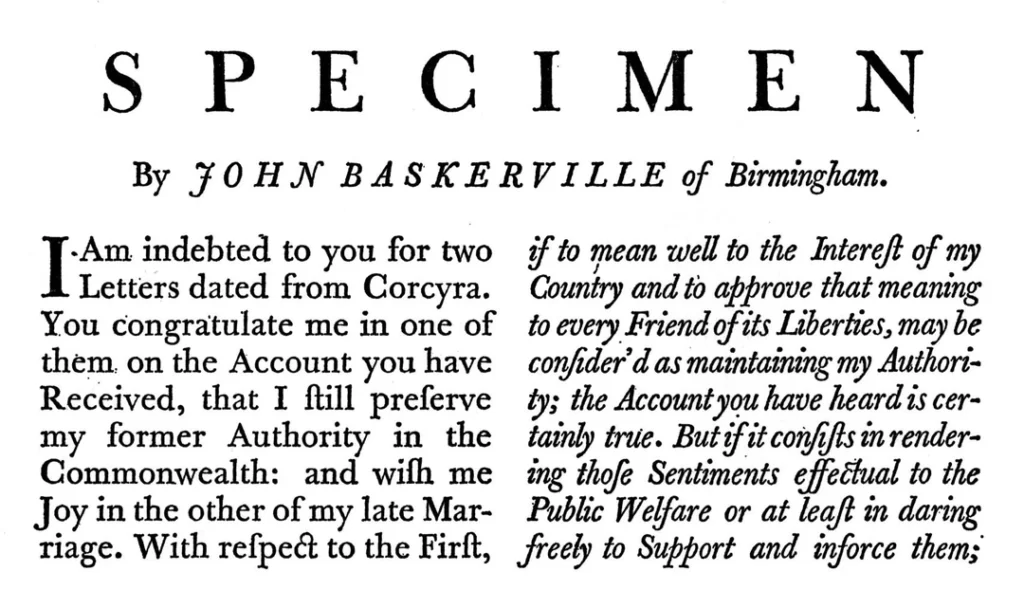
Baskerville in Literature and Beyond
Widely recognised for its beauty and readability on paperbacks, novels, or any other works of fiction printed by publishers worldwide, literature was not only the place where this typeface was found but also various fields such as academic publishing or branding.
Digital Renaissance of Baskerville
Since digitalisation took off, many classic fonts got another chance to shine through their revived versions brought into life by contemporary typographers who managed to keep up with times without losing touch with historical roots — one of them being the Baskervilles revival which happened during the late XX century having most significant impact till now
7. Gotham: The 21st Century Sans-Serif
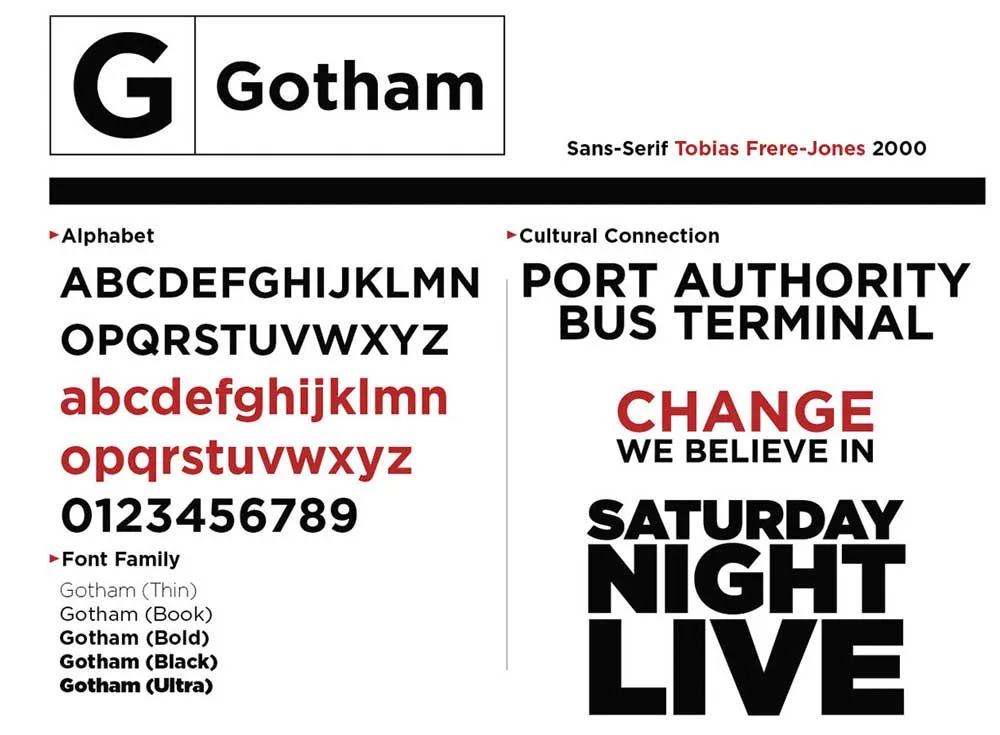
Though several of our best fonts have been around for hundreds of years, Gotham shows that newer typefaces can be just as impactful. One of the most influential fonts created in the twenty-first century, Gotham, was designed by Tobias Frere-Jones in 2000. So what is it about Gotham?
A Child of New York City
Gotham’s design comes from the lettering on buildings and signs all over New York. Because of this urban influence, it has a uniquely American flavour.
Basic Information About Gotham
What sets Gotham apart from other sans-serifs? Here are some traits to look for:
- Geometric structure with humanist touches
- Many different weights and widths are available
- Friendly, open letterforms
- An adaptable design that works well both as display type and in text settings

Gotham’s Role in Politics and Popular Culture
When Obama used it during his 2008 presidential campaign, Gotham became famous. Since then, many brands or organisations wanting to appear current or personable have turned to this font as their go-to.
The Growing Family Of Gothams
Other versions, such as condensed or rounded, were made after being introduced into the world. This only added more uses and fans for Gotham
8. Frutiger: The Wayfinding Wonder
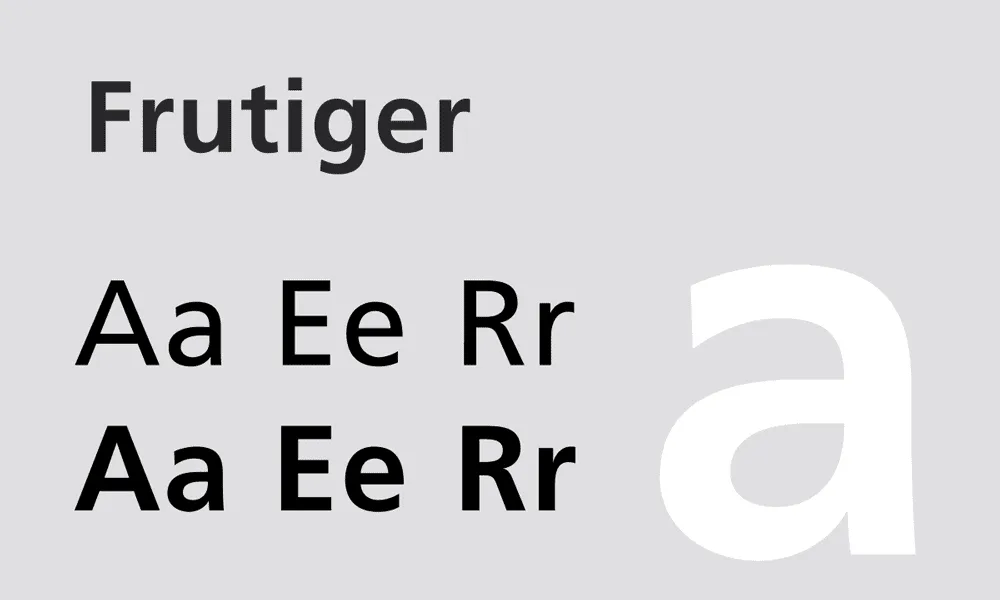
When it comes to readability in extreme conditions, nothing beats Frutiger. Designed by Adrian Frutiger in 1968 for Charles de Gaulle Airport in Paris, this sans-serif typeface was used as a ubiquitous signage and wayfinding system worldwide. But why is it so good? Let’s find out.
A Unique Invention
Frutiger was created to solve one problem: finding a typeface that can be skimmed from any angle or distance without causing confusion or eye strain. This utilitarian origin sets it apart from most other fonts on this list.
Special features of Frutiger
What makes frutiger highly legible and versatile? Here are some distinctive features:
- Open letterforms with generous spacing
- Clear differentiation between similar characters such as I, l and 1
- A combination of humanist and geometric qualities that is well-balanced
- There is a slight variation in stroke width, which enhances readability

More than just signposts
Though particularly successful in wayfinding applications, Frutiger is no longer restricted to airports and railway stations; it has become widely used for branding, packaging design and web interfaces, among many others.
Developments in the Frutiger Typeface
Since its first release, various revisions and extensions have been made to the font itself; examples include the ‘Frutiger Next’ and ‘Frutiger Neue’ families, which built upon the original design, thus ensuring relevancy within digital age platforms, too.
9. Gill Sans: The British Modern Classic
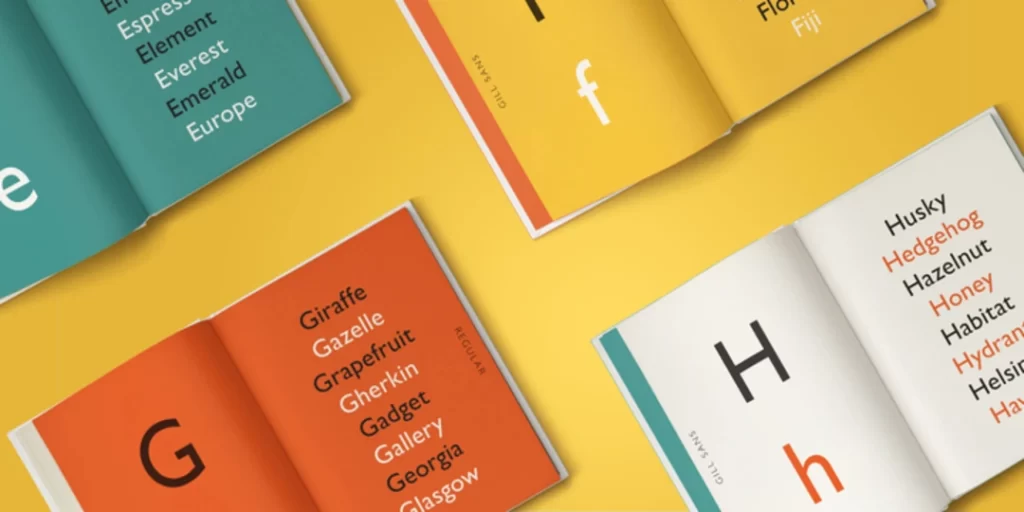
There can be no list of top design fonts without Gill Sans. It is a British typeface created by Eric Gill in the 1920s. Since then, it has evolved into one of the world’s most popular and loved sans-serif fonts. Let’s take a look at what makes this font so great.
Sans-serif with a Humanist Approach
Gill Sans differentiates itself from other sans-serif typefaces of its time by including humanist elements. This combination of geometric structure and calligraphic influence gives Gill Sans its unique feel.
Distinctive Features of Gill Sans
What makes Gill Sans different from other sans-serifs? Here are some notable characteristics:
- Balanced proportions inspired by Roman capitals
- Subtle variations in stroke width
- Distinctive ‘a’ and ‘g’ with their curved tails
- Wide variety of weights, from ultra-light to extra-bold

Gill Sans in British Culture
This typeface has deeply penetrated visual culture in Britain. For the BBC logo or London Underground signage, no other font played such a significant role in the UK design scene as Gill Sans did.
The Digital Life of Gill Sans
Like any classic typeface, Gill Sans was adopted for use in digital media. In 2015, an extended version called “Gill Sans Nova” was released, which expanded upon the original design but retained its uniqueness.
10. Palatino: The Renaissance-Inspired Workhorse
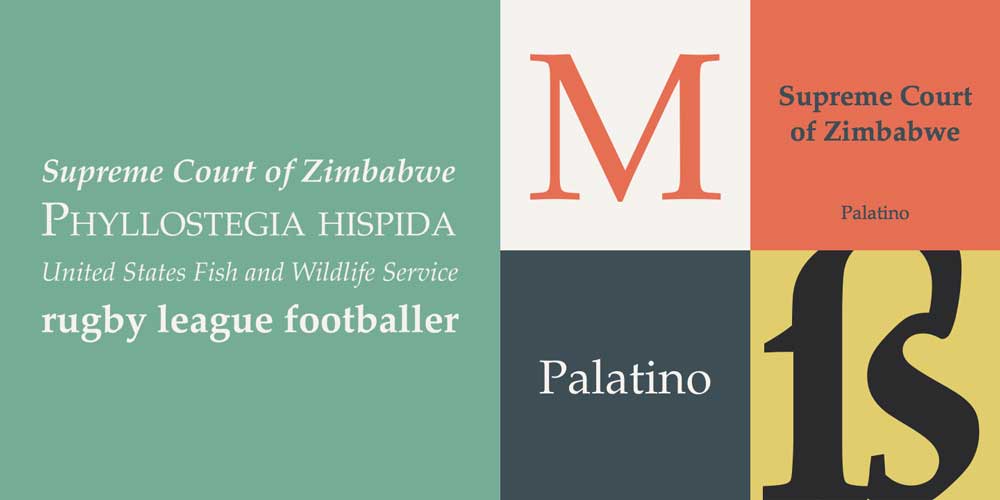
Our number ten is Palatino, which is a typeface that combines features of old-style and modern serifs. Designed by Hermann Zapf in 1948, it has become one of the most widely used book typefaces and general-purpose texts. Let’s look at why Palatino has endured.
Italian Renaissance Influence
Zapf used Italian Renaissance calligraphy and typography cues to create an ancient and new font.
Palatino’s Distinctive Traits
But what is it about Palatino that makes it special? Here are some of its unique characteristics:
- The X-height is slightly higher than traditional old-style serifs
- Curves – graceful and sweeping lines
- Thickness contrast – not too much difference between thick strokes and thin ones
- Serifs are strong enough to be legible when printed small
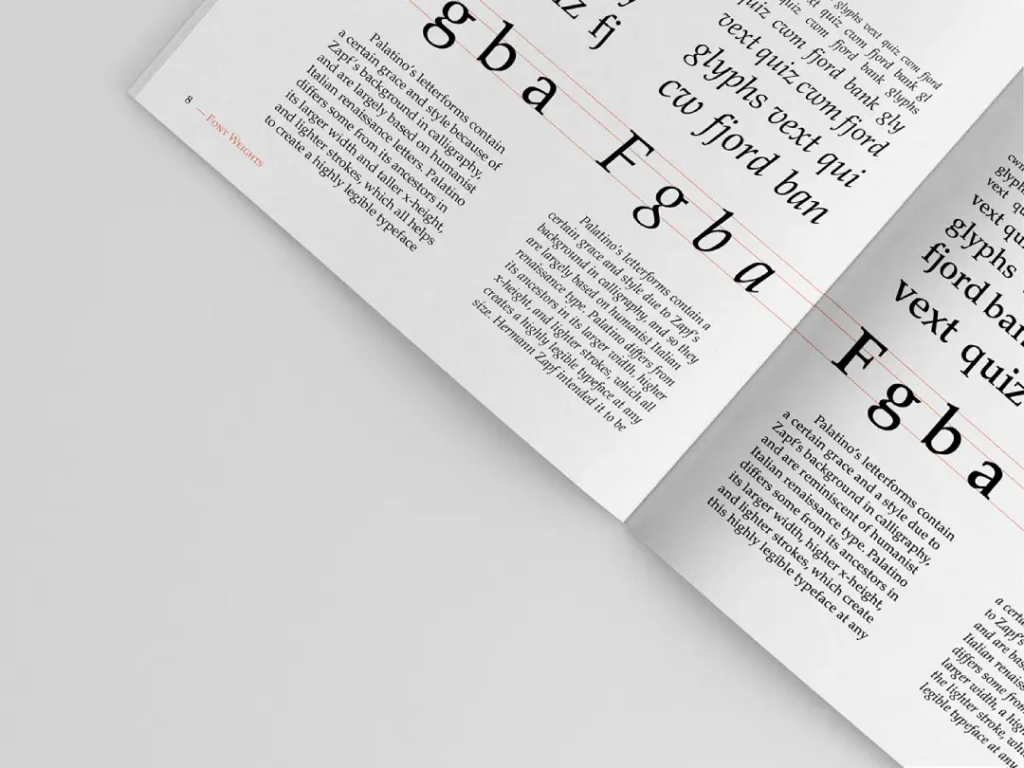
Use of Palatino in Print Media And Digital Formats
For many years after its release, this typeface was widely used in books because it was easy to read while still being beautiful. With the advent of computers came digital representation, making palatinate aperçu on screen or paper possible without losing quality.
Growth Of The Palatine Font Family
Many different versions have been created over time by various designers working alongside Zapf himself; however, none were more successful than those brought about through collaboration between these two parties. Among them include but are not limited to:
- Extra Bold Italic Condensed
- Light Oblique Narrow
- Light Roman Wide Extended
- Heavy Fraktur Blackletter
As late as the early 2000s, we saw even further developments with an introduction into marketplaces such as Linotype, where they introduced new designs like the Palantino Nova family (which had an expanded original design).
The Impact of These Timeless Typefaces
As we have seen, these top 10 design fonts have impacted typography and visual communication immensely. Every one of these typefaces has influenced how we understand or engage with the text, from Helvetica being everywhere to Garamond’s never-ending beauty.
The Significance of Typography in Design
Choosing a beautiful font isn’t what typography does. It is a crucial design element that can express feelings, create order, and improve legibility. These fonts have repeatedly proven themselves worthy in such areas.
Flexibility in the Digital Era
Another thing that binds these popular fonts is how well they adapt to new technologies. These styles retained their defining features throughout their transformation from hot metal type to digital screens.
Typography of the Future
These timeless fonts will always shape even more modern ones as time goes by. Good typographical principles represented by this lettering – readability, versatility, aesthetic appeal – will not become obsolete because of any technological advancements.
What Are Some Classic Fonts That Every Designer Should Own?
In the ever-evolving design world, certain typefaces have withstood the test of time. They blend style and practicality, making them essential for any designer’s toolkit. Here’s a guide to the classic fonts that embody timelessness and versatility.
Orpheus
Background: Orpheus is rooted in the late 1920s, bringing forth a flowing and calligraphic style. Its design pays homage to its origins while offering a modern alternative to more rigid serif fonts.
Why You Need It: With its ethereal and refined look, Orpheus is favoured for projects that require a touch of elegance and intellect, making it a choice for branding that evokes a feminine and sophisticated feel.
Canela
Background: Designed with an influence from serif and sans serif fonts, Canela is a modern typeface with a historical twist. Its stone-carving-inspired appeal gives it an inscribed feel.
Why You Need It: Canela’s ability to straddle the line between serif and sans serif gives it an enviable timelessness. It’s perfect when you need a typeface that feels both current and classic.
Open Sans
Background: Born from a need for high legibility in digital formats, Open Sans has been a staple in web design since its creation. It’s a humanist sans serif known for its clarity.
Why You Need It: Open Sans is versatile and neutral, suitable for various web applications. Its clean lines and readability make it an evergreen choice for content-heavy designs.
Akzidenz Grotesk
Background: This typeface emerged in the late 19th century and inspired the minimalist trends of the International Style in the post-war era.
Why You Need It: Akzidenz Grotesk is ageless, providing a simple yet distinctive sans-serif flavour. Its unique rounder feel makes it a fresh alternative for web and print designs.
Avenir
Background: Avenir blends geometric clarity with a touch of organic softness. Its name, meaning “future” in French, hints at its enduring appeal.
Why You Need It: It’s a harmonious blend of elegance and neutrality, ideal for logos, signage, and political branding. Avenir offers a more approachable option compared to other geometric sans serifs.
Gotham
Background: Created for modern editorial needs, Gotham has thrived in popular media and political campaigns thanks to its trustworthiness and solid design.
Why You Need It: Gotham embodies contemporary sans-serif design with a familiar and fresh appeal. Its successful track record in media lends it a timeless quality.
Franklin Gothic
Background: With roots in early 20th-century type design, Franklin Gothic carries a robust, newspaper-style aesthetic.
Why You Need It: Its commanding presence and legibility make it ideal for grabbing attention in both print and digital formats, providing authority and clarity in headlines and content.
Gill Sans
Background: Known for its British heritage, Gill Sans is a typeface with inscriptional beauty, adapted widely across multiple platforms.
Why You Need It: Gill Sans brings a touch of intellectualism and versatility, and it is well-suited for everything from academia to packaging design.
Trade Gothic
Background: Emerging from the mid-20th century, Trade Gothic is a font that bridges vintage charm with modern versatility.
Why You Need It: It’s perfect for headlines and body text, fitting seamlessly into any design with a hint of vintage flair without compromising contemporary appeal.
Brandon Grotesque
Background: With a nod to 1920s-type styles, Brandon Grotesque combines geometric design with a friendly demeanour.
Why You Need It: Its well-rounded design and formal angles make it adaptable for almost any project. It’s a perfect blend of vintage appeal and present-day adaptability.
These fonts are more than just styles—they are tools that bring character and clarity to your design projects. Owning these classics ensures you’re ready to meet various design challenges with timeless solutions.
Conclusion: The Lasting Legacy of Great Typography
Typography is an excellent concept in design which can be used over time and across different technologies as we conclude our journey through the top ten fonts of all time for this design course. These designs have transformed our visual environment, as seen in books and street signs where travellers pass by.
The knowledge of these timeless typefaces is essential to any designer, whether new or experienced, because it sets the basis for effective design creation. Every font has a narrative behind it; how was it made? How has it changed over time? What impact did that particular style have on communication through images?
In this era of computers and smartphones, we need to hold on to classic type styles as reference points when coming up with new ones. Trends will always come and go, but sound principles remain the same even in digitalised typography.
Therefore, do not forget these significant typographical symbols while selecting one for use during your project planning stage so that you can understand its origin better – who knows what might happen if only people were aware enough? You may stumble upon an ideal candidate for expressing yourself visually through words!
FAQs
What makes these the best design fonts of all time?
These fonts have been chosen because they are historically significant, widely used, versatile and have had a lasting impact on design and typographic practice. Their worth has been proven in many different media, and they have inspired countless other typefaces.
Can these be used in both print and digital form?
All of them were created for digital use but can still work well when printed. However, some might be better suited to certain media than others, so it is always advisable that you test your font selections within their intended environments.
Are they free to use for my projects?
Although some versions could be obtained without charge, most commercial typefaces require licenses before being utilised elsewhere; therefore, one should examine license agreements before using any such font within their project(s).
How do I know which one is right for my project?
Think about what sort of mood you want to create, how readable it needs to be or where and when people will see/read/use this particular piece of work, etc.; try out different options – never hesitate to mix several fonts as such action might add more visual appeal.
Are there any future additions to current fonts that are considered old-fashioned now?
Surely! Typography changes fast, with new faces coming up every time; modern ones like Roboto (Android), Open Sans (Google Web Fonts) & Inter may soon become classics just like their predecessors did over years past.
Is typography essential in the overall design?
Absolutely, yes! It determines legibility and sets tone/style/voice, thus affecting readership perception/engagement level(s).

